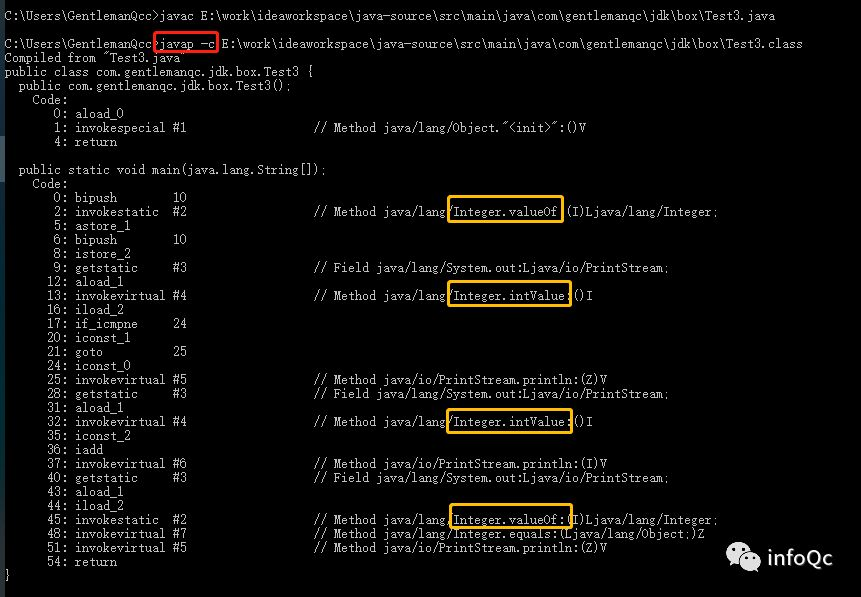微信公众号:infoQc如有问题或建议,请公众号留言最近更新:2018-08-19
包装类型
在讲解正文之前,我很想问这么一个问题:"Java为我们提供了8种基本数据类型,为什么还需要提供各自的包装类型呢?"。您可能会觉得这个问题问的很奇怪,但是我觉得还是值的思考的。 因为Java是一门面向对象的语言,基本数据类型并不具备对象的性质。而包装类型则是在基本类型的基础上,添加了属性和方法,从而成为了对象。试想,一个int类型怎么添加到List集合中?
自动拆箱与装箱
概念:
首先,我们来看一个例子:
1Integer number = 10; //自动装箱2int count = number; //自动拆箱基本数据类型自动转化为包装类型时,即为自动装箱。 反之,包装类型自动转化为基本数据类型时,即为自动拆箱。 看概念您是不是觉得很简单,但真的这么"简单"吗?不妨我们来看两道题。
实操:
-
题目一:
1int z = 127; 2Integer a = 127; 3Integer b = Integer.valueOf(127); 4Integer f = new Integer(127); 5Integer g = new Integer(127); 6 7int y = 128; 8Integer c = 128; 9Integer d = Integer.valueOf(128);10Integer e = new Integer(128);11Integer h = new Integer(128);1213System.out.println("z==a结果:" + (z == a));14System.out.println("z==b结果:" + (z == b));15System.out.println("z==f结果:" + (z == f));16System.out.println("a==b结果:" + (a == b));17System.out.println("a==f结果:" + (a == f));18System.out.println("f==g结果:" + (f == g));1920System.out.println("y==c结果:" + (y == c));21System.out.println("y==d结果:" + (y == d));22System.out.println("y==e结果:" + (y == e));23System.out.println("c==d结果:" + (c == d));24System.out.println("c==e结果:" + (c == e));25System.out.println("e==h结果:" + (e == h));-
题目二:
1Integer i = 1; 2Integer j = 2; 3Integer k = 3; 4Long m = 3L; 5Long n = 2L; 6System.out.println("k==i+j结果:" + (k == i + j)); 7System.out.println("k.equals(i+j)结果:" + (k.equals(i + j))); 8System.out.println("m==i+j结果:" + (m == i + j)); 9System.out.println("m.equals(i+j)结果:" + (m.equals(i + j)));10System.out.println("m.equals(i+n)结果:" + (m.equals(i + n)));思考:
-
什么情况会触发自动装箱操作? 当基本类型赋值给包装类型引用时,会触发自动装箱操作,调用包装类型的valueOf()方法。
-
什么情况会触发自动拆箱操作? 当包装类型参与运算时会触发自动拆箱操作,调用包装类型对应的***Value()方法,例如Integer类为intValue()。Why?因为运算是基本数据类型要做的事情。
补充:此处利用java提供的反汇编器javap,查看java编译器为我们生成的字节码。通过它,我们可以对照源代码和字节码,来对上述观点进行论证。
1Integer number = 10;//自动装箱2int number2 = 10;3Integer number3 = 10;4System.out.println(number == number2);//自动拆箱5System.out.println(number + number3);//自动拆箱6System.out.println(number.equals(number2));//自动装箱
-
Integer的valueOf()和intValue()又是如何实现的呢?
话不多说,我们来看下Integer这两个方法的源码:
1public int intValue() {2 return value;3}45public static Integer valueOf(int i) {6 if (i >= IntegerCache.low && i <= IntegerCache.high)7 return IntegerCache.cache[i + (-IntegerCache.low)];8 return new Integer(i);9}intValue()很简单,返回Integer对象的value值。 valueOf()判断当前int值是否在IntegerCache的区间内(-128~127),在则从IntegerCache的cache数组中获取指定位置的Integer对象,否则创建一个Integer对象,value值为i。 抱着打破砂锅问到底的态度,我们继续看下IntegerCache源码:
1private static class IntegerCache { 2 static final int low = -128; 3 static final int high; 4 static final Integer cache[]; 5 6 static { 7 // high value may be configured by property 8 int h = 127; 9 String integerCacheHighPropValue =10 sun.misc.VM.getSavedProperty("java.lang.Integer.IntegerCache.high");11 if (integerCacheHighPropValue != null) {12 try {13 int i = parseInt(integerCacheHighPropValue);14 i = Math.max(i, 127);15 // Maximum array size is Integer.MAX_VALUE16 h = Math.min(i, Integer.MAX_VALUE - (-low) -1);17 } catch( NumberFormatException nfe) {18 // If the property cannot be parsed into an int, ignore it.19 }20 }21 high = h;2223 cache = new Integer[(high - low) + 1];24 int j = low;25 for(int k = 0; k < cache.length; k++)26 cache[k] = new Integer(j++);2728 // range [-128, 127] must be interned (JLS7 5.1.7)29 assert IntegerCache.high >= 127;30 }3132 private IntegerCache() {}33}IntegerCache作为Integer私有静态内部类,定义了静态语句块,在类加载时会被调用。做什么呢?按照low和high默认为-128~127,依次创建对应数值的Integer对象,并放入cache数组中,作为缓存。通过valueOf()源码,我们知道,那里就是体现它缓存价值的地方。 补充:缓存里下限-128不可变,上限默认为127,可以通过java -Djava.lang.Integer.IntegerCache.high=***来动态调整。
实操分析:
有了上述的知识储备,我们回顾一下之前的两道题目,是不是容易了很多?
-
题目一解析:
1int z = 127; 2Integer a = 127; 3Integer b = Integer.valueOf(127); 4Integer f = new Integer(127); 5Integer g = new Integer(127); 6 7int y = 128; 8Integer c = 128; 9Integer d = Integer.valueOf(128);10Integer e = new Integer(128);11Integer h = new Integer(128);1213System.out.println("z==a结果:" + (z == a));//true 和基本数据类型做==,比较的是值,故包装类型会自动拆箱14System.out.println("z==b结果:" + (z == b));//true 同理,自动拆箱15System.out.println("z==f结果:" + (z == f));//true 同理,自动拆箱16System.out.println("a==b结果:" + (a == b));//true 因127在IntegerCache的-128~127范围内,故采用缓存里的对象,故二者引用地址一致17System.out.println("a==f结果:" + (a == f));//false 对象之间==,比较的是引用,因为a指向IntegerCache里缓存的对象,f指向的new出来的对象,故引用地址不同18System.out.println("f==g结果:" + (f == g));//false f和g都是自己new出来的对象,故引用地址不同1920System.out.println("y==c结果:" + (y == c));//true 自动拆箱21System.out.println("y==d结果:" + (y == d));//true 自动拆箱22System.out.println("y==e结果:" + (y == e));//true 自动拆箱23System.out.println("c==d结果:" + (c == d));//false 因128不在IntegerCache的-128~127范围内,故采用缓存里的对象,故二者引用地址一致24System.out.println("c==e结果:" + (c == e));//false 引用地址不同25System.out.println("e==h结果:" + (e == h));//false 引用地址不同-
题目二解析:
1Integer i = 1; 2Integer j = 2; 3Integer k = 3; 4Long m = 3L; 5Long n = 2L; 6 7System.out.println("k==i+j结果:" + (k == i + j));//true 首先+操作是数值操作,故i和j会自动拆箱,结果为基本类型int 3。然后k自动拆箱,进行值比较3==3 8System.out.println("k.equals(i+j)结果:" + (k.equals(i + j)));//true 首先+操作是数值操作,故i和j会自动拆箱,结果为基本类型int 3。 9// 然后调用equals(Object o)方法,此时int 3自动装箱,为Integer 3。Integer类的equals方法里比较的是值,故为true1011System.out.println("m==i+j结果:" + (m == i + j));//true 先i和j自动拆箱,再m自动拆箱,比较值。int自动提升为long,值一致为true12System.out.println("m.equals(i+j)结果:" + (m.equals(i + j)));//false 先i和j自动拆箱,equals(Object o)再自动装箱,为Integer 3。Long和Integer类型不一致,返回false13System.out.println("m.equals(i+n)结果:" + (m.equals(i + n)));//true 先i和j自动拆箱,int自动提升为long,故为long 3L。再自动装箱为Long 3,返回trueJava缓存机制
Java为了在自动装箱时避免每次去创建包装类型,采用了缓存技术。即在类加载时,初始化一定数量的常用数据对象(即常说的热点数据),放入缓存中,等到使用时直接命中缓存,减少资源浪费。 通过查看源码发现,Java提供的8种基本数据类型,除了float和double外,都采用了缓存机制。其实原因也很简单,因为浮点型数据,热点数据并不好确定,故并未采用。 最后给出各类型缓存范围: Character: 0~127 Byte,Short,Integer,Long: -128 到 127 Boolean: true,false 大家再遇到类似题目时,就可以正确的做出判断啦。